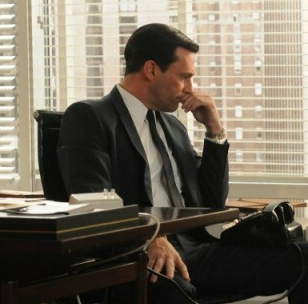The sexism on Mad Men, for better or worse, is part of the show’s appeal. It’s part of the “we’re all in on the joke as we look back in amusement at a bygone era” humor. Heck, when Don Draper (a creative director) makes his famous Kodak Carousel pitch, there isn’t a female even in the room, save for a secretary, whom he asks to turn out the lights by merely referring to her as “sweetheart.” (And it should be noted that Sterling Cooper’s Harry Crane is the character that runs from the room crying after Don’s emotional speech.)
Does Don know that it is most likely a woman who will be buying the Carousel? Probably not. If he were making the pitch today, he would know that women make 85 percent of all consumer purchases,$7 billion in total according to research compiled by the Terri & Sandy Solution, an agency founded by creative directors Terri Meyer and Sandy Greenberg. (Yes, Don, Terri and Sandy are women.)
Only 3 percent of creative directors in advertising are female.
What other interesting statistics has the Terri & Sandy Solution accumulated in regard to women and their purchasing power? Well, women purchase over 50 percent of “traditionally male” products. Women are responsible for 58 percent of online retail spending. This rattling off of statistics could go on and on, but the one that may be most important is that women feel misunderstood by advertisers.
What is this reason for women feeling misunderstood? It could be because traditional advertising agencies have been male-dominated, and only 3 percent of creative directors in advertising are female. But there is good news to be found in this sobering statistic:The 3% Conference is an organization that is working on rectifying the problem. It is attempting to change this through its mission “to build the business case for diversity by championing female creative talent and leadership by offering content, community and professional development.” The founder of the 3% Conference is Kat Gordon.
Gordon was a 20-year copywriter and creative director who “saw firsthand how women were left out of pitches and important meetings,” according to the 3% Conference website. She realized the gravity of the problem “the day her agency pitched the Saab car account with 16 men and one woman, and then was mystified why they didn’t get the business.”
“There are only three consumer categories where men dominate purchases, yet agencies still talk about ‘women’s accounts’ as mops and makeup,” Gordon says. “The truth is that women are the superset, not the subset, and the rate at which women are amassing wealth and exerting influence is unprecedented.”
Women feel misunderstood by advertisers.
The most important idea behind Gordon’s resolve to remedy this problem is a mere two-word phrase: lack of. This means, according to the 3% Conference, there’s a “lack of support for motherhood, lack of mentorship, lack of awareness that femaleness is an asset to connecting to the consumer marketplace today, lack of celebration of female work due to gender bias of award juries, lack of women negotiating their first agency salary and every one thereafter.” So the question became this: How to?



